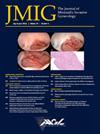Intraoperative Delineation of Bladder Deep Endometriosis: Optimizing Excision Margins for Postoperative Bladder Capacity Preservation
IF 3.5
2区 医学
Q1 OBSTETRICS & GYNECOLOGY
引用次数: 0
Abstract
Study Objective
To demonstrate the implementation of robotic integrated ultrasound alongside meticulous dissection and cystoscopic guidance in the surgical excision of deep endometriosis nodules, to prevent persistent or recurrent disease without sacrificing normal bladder wall, thereby optimizing postoperative bladder capacity.
Design
This study presents a case report detailing the proposed surgical technique.
Setting
Academic tertiary referral center.
Patients or Participants
A 45-yo-woman with a history of hysterectomy for fibroids presenting with persistent symptoms suggestive of urinary tract infection and hematuria.
Interventions
Surgical excision with robotic assistance, cystoscopic guidance and incorporation of robotic integrated ultrasound for precise delineation of lesion margins.
Measurements and Main Results
The patient had an uneventful postoperative course with symptom resolution. Pathology confirmed full thickness endometriosis lesion with free margins.
Conclusion
The integration of intraoperative ultrasound with meticulous dissection and cystoscopic guidance represents a reproducible approach for the precise delineation of bladder deep endometriosis nodules. This technique is an effective methodology for optimizing excision margins while concurrently preserving the integrity of the normal bladder wall.
膀胱深部子宫内膜异位症的术中界定:优化切除边缘,术后保留膀胱容量
研究目的 展示在手术切除深部子宫内膜异位症结节时,如何利用机器人综合超声技术,配合精细解剖和膀胱镜引导,在不牺牲正常膀胱壁的情况下防止疾病持续或复发,从而优化术后膀胱容量。患者或参与者一名45岁女性,曾因子宫肌瘤行子宫切除术,并伴有尿路感染和血尿的持续症状。干预措施在机器人辅助下进行手术切除,膀胱镜引导,并结合机器人综合超声精确划定病灶边缘。病理证实为全厚度子宫内膜异位症病灶,边缘游离。结论术中超声与精细解剖和膀胱镜引导的整合是精确划分膀胱深部子宫内膜异位症结节的一种可重复方法。这项技术是优化切除边缘的有效方法,同时还能保护正常膀胱壁的完整性。
本文章由计算机程序翻译,如有差异,请以英文原文为准。
求助全文
约1分钟内获得全文
求助全文
来源期刊
CiteScore
5.00
自引率
7.30%
发文量
272
审稿时长
37 days
期刊介绍:
The Journal of Minimally Invasive Gynecology, formerly titled The Journal of the American Association of Gynecologic Laparoscopists, is an international clinical forum for the exchange and dissemination of ideas, findings and techniques relevant to gynecologic endoscopy and other minimally invasive procedures. The Journal, which presents research, clinical opinions and case reports from the brightest minds in gynecologic surgery, is an authoritative source informing practicing physicians of the latest, cutting-edge developments occurring in this emerging field.

 求助内容:
求助内容: 应助结果提醒方式:
应助结果提醒方式:


